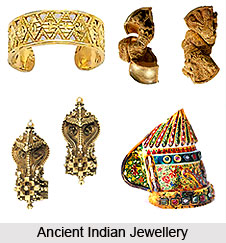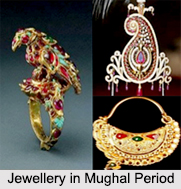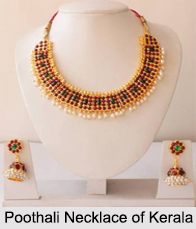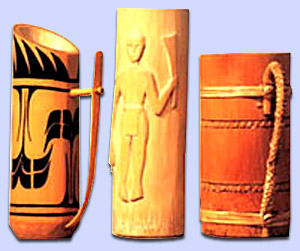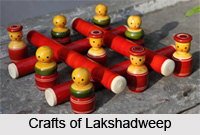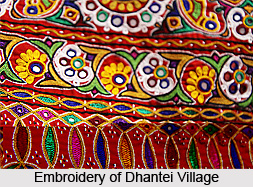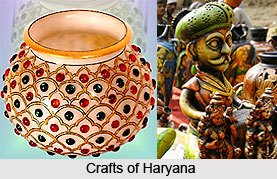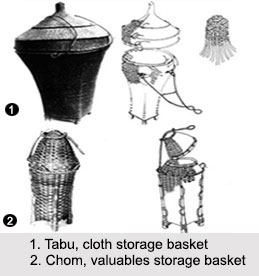 Products made of cane and bamboo are as prominent and indispensable among the tribal belts inhabiting the hills of Manipur, as the Meitheis in the valley. One of such products used by the Maring tribal belt, is a box with lid called Pongsang Lapak, made from the pulpy layer of the bamboo. In making this specific box, the Marings cut up the bamboo into several pieces. The hard outer layer is sliced off bit by bit using a Thangjou, until the pulpy layer within is left fully exposed. The next step is the application of the juice of Khrat, a poisonous plant used by the Marings. It is applied thoroughly all over the outer surface of the bamboo and then heated over fire. This is done to prevent the softer layer of the bamboo from breaking when folded. After being properly exposed to fire, the bamboo piece is split vertically into two. The curved split pieces are then straightened out. Finally, the straightened split pieces are folded into oval-shaped structures which form the framework of the box. The lid and the body of the box are similar in shape, with the body slightly smaller than the lid in size.
Products made of cane and bamboo are as prominent and indispensable among the tribal belts inhabiting the hills of Manipur, as the Meitheis in the valley. One of such products used by the Maring tribal belt, is a box with lid called Pongsang Lapak, made from the pulpy layer of the bamboo. In making this specific box, the Marings cut up the bamboo into several pieces. The hard outer layer is sliced off bit by bit using a Thangjou, until the pulpy layer within is left fully exposed. The next step is the application of the juice of Khrat, a poisonous plant used by the Marings. It is applied thoroughly all over the outer surface of the bamboo and then heated over fire. This is done to prevent the softer layer of the bamboo from breaking when folded. After being properly exposed to fire, the bamboo piece is split vertically into two. The curved split pieces are then straightened out. Finally, the straightened split pieces are folded into oval-shaped structures which form the framework of the box. The lid and the body of the box are similar in shape, with the body slightly smaller than the lid in size.
Baskets are again the most prominent category among cane and bamboo crafts of the tribal people in the hills of Manipur. Conical baskets in great numbers are still being used amongst them, as by the men and women of certain Loi hamlets. People in the hills have also been using container baskets since long, for keeping items of daily use. Although such use has been given up to a great extent, it is nonetheless in continuance even today. The container baskets have no fixed size. The size of such a basket is determined by the purpose which it is particularly going to be used for. The tribal belts also use container baskets to keep yarn meant for making cloth and storing grain, rice etc. They are also used to keep rice beer, contained in "tumba", a container made from the dried hollowed out skin of a gourd.
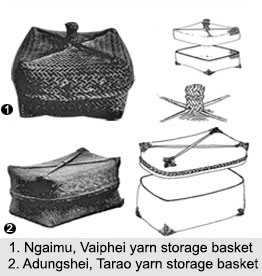 In Manipur, there is a practice of collecting ash by burning sun dried "Laphu-maka" or the outer layers of banana stems, straws and pea plants, amongst the people living in the hills as well as in the valley. The three ingredients are burnt together and the ash thus obtained is used in the preparation of the curry dish Utee. For filtering the ash, a small basket called Shek is used. The Shek is conical in shape, with a circular mouth and a tapering end. On two sides of the circular mouth are extended flaps that act as hand holds, along with a tiny hole maintained at the tip of the tapering end, allowing the filtered solution to pour out. The ash initially collected is first put into the Shek through the open mouth, and water is then poured over it. The filtered solution that comes out is referred to as Kari, an alkaline substance used in the preparation of Utee. The Shek used by the tribal people is of a much bigger size than those used by the Meitheis.
In Manipur, there is a practice of collecting ash by burning sun dried "Laphu-maka" or the outer layers of banana stems, straws and pea plants, amongst the people living in the hills as well as in the valley. The three ingredients are burnt together and the ash thus obtained is used in the preparation of the curry dish Utee. For filtering the ash, a small basket called Shek is used. The Shek is conical in shape, with a circular mouth and a tapering end. On two sides of the circular mouth are extended flaps that act as hand holds, along with a tiny hole maintained at the tip of the tapering end, allowing the filtered solution to pour out. The ash initially collected is first put into the Shek through the open mouth, and water is then poured over it. The filtered solution that comes out is referred to as Kari, an alkaline substance used in the preparation of Utee. The Shek used by the tribal people is of a much bigger size than those used by the Meitheis.
Storage baskets are also used for varied purposes in Manipur and all the tribal groups in the state use a big storage basket with lid, called Tabu, for mainly storing clothes. To enable the men folk to carry such baskets from one place to another, there is a marked position for fixing the straps referred to as Namlee, even without any given holes or loops in the Tabu. Occasionally, to enable carriage of the Tabu from one place to another, straps meant for hand holds are fixed on the upper portion of the basket. In order to secure the lid tightly with the body of the Tabu, a long strap is separately attached to act like a lock. The Tabus slightly differ in feature from one tribe to another and are used by them to store clothes, household utensils and other items to be presented and delivered to the bridegroom`s place as dowry, when a girl gets married. When a tribal girl gets married, it is generally enquired as to how many Tabus are being presented as dowry. People having daughters in their family either make or buy Tabus, and store them in preparation for the eventful day. Tabus are also used in Manipur to store clothes of the officers of the land, and are carried from one village to another in the wake of officials when they move about for their duties.
The structure of the Tabus meant for storing clothes encompasses a double weave: one inner and an outer weave. For the inner weave, the basic form is structure of the bamboo, to which a layer of certain select dry leaves is added. Cane splits are then woven above this layer of dry leaves. The objective of inserting this intermediary layer of dry leaves in between the inner and the outer weaves is to make the basket water resistant against raindrops. The Kom tribal people sometimes keep such baskets up on the shelves of their houses, while generally it is kept inside a room in the house. Maintaining the form of the Tabu basket with double weaving technique, the people of the Tangkhul tribe make small baskets called Chom, to store valuable items.
The tribes of Manipur also use a small basket with lid for storing yarn and other valuable items, called Ngaimu. It is used by the Vaipheis who have ingeniously contrived a handle on the lid serving as the hand hold.
Related Articles:
Bamboo and Cane Crafts of Manipur
Crafts of Manipur
Baskets
Basket Weaving Techniques in Manipur
Tribes of Manipur, Indian Tribals
Cane and Bamboo Products of Manipur
Meithei Language
Manipur
Baskets used by Tribes of Manipur
